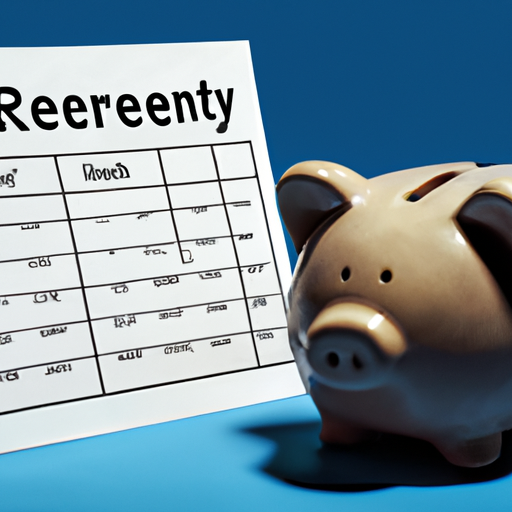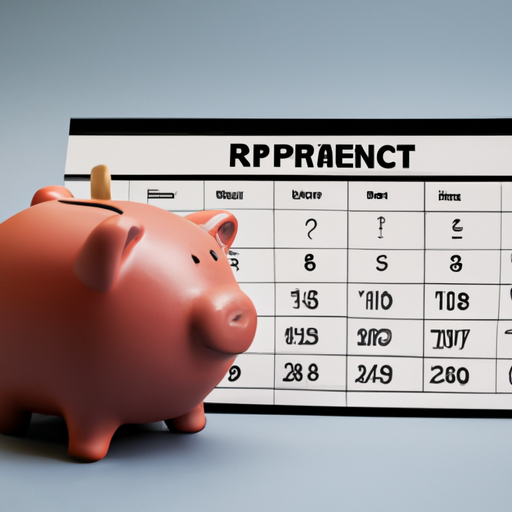Have you ever wondered when is the right time to start planning for retirement and how much money you need to save? These questions may seem daunting, but they are important for securing your financial future. In this article ‘The Ultimate Guide to Early Retirement Planning: When and How Much to Save’, we will explore the answers to these crucial inquiries, providing guidance and insights to help you make informed decisions about your retirement planning. So, let’s dive in and find out when and how much!

The Importance of Early Retirement Planning
Retirement planning is a crucial step in securing your financial future. It’s never too early to start thinking about retirement, and the earlier you begin planning, the better prepared you’ll be for this new chapter in your life. Early retirement planning provides you with more time to save and benefit from compound interest. It also allows you to prepare for unexpected circumstances that may arise later in life.
Starting Early Provides More Time to Save
One of the most significant advantages of starting your retirement planning early is that it gives you more time to save for retirement. By starting early, you have the opportunity to set aside smaller amounts of money over a more extended period. This approach allows your savings to grow steadily over time, making it easier to achieve your retirement savings goals.
The power of compounding is crucial when it comes to retirement savings. Compound interest is the interest you earn on both the initial amount you save and the interest that accumulates over time. Starting early gives you a greater opportunity to take advantage of this compounding effect, allowing your savings to grow exponentially over the years.
Preparing for Unexpected Circumstances
Life is full of uncertainties, and planning early for retirement allows you to prepare for the unexpected. By starting your retirement planning early, you can build a financial buffer to protect yourself and your loved ones in case of emergencies or unforeseen circumstances. This safety net can be essential in maintaining your financial stability and ensuring a comfortable retirement.
Planning for unexpected circumstances involves considering factors like insurance coverage, emergency funds, and estate planning. By addressing these areas early on, you can protect your retirement savings and minimize potential disruptions to your financial well-being.
Factors to Consider When Planning for Retirement
When planning for retirement, there are several factors that you should consider to ensure that you have adequate savings to support your lifestyle. These factors include your current age, life expectancy, healthcare needs, social security benefits, and inflation rates.
Current Age and Retirement Age
Your current age is an essential factor to consider when planning for retirement. The earlier you start planning, the more time you have to accumulate savings. However, even if you start planning later in life, it’s never too late to make a positive impact on your retirement finances.
Your desired retirement age also plays a crucial role in your retirement planning. The earlier you plan to retire, the more you’ll need to save to sustain your lifestyle. However, if you plan to work longer, you may have more time to save and delay accessing your retirement funds.
Life Expectancy
Another important consideration when planning for retirement is your life expectancy. Although it’s impossible to predict how long you’ll live, estimating your life expectancy can help you determine how many years your retirement savings need to sustain you. Consider factors such as your health, family history, and lifestyle choices when estimating your life expectancy.
Healthcare Needs
Healthcare costs are a significant expense in retirement, and it’s crucial to consider these expenses when planning for your future. As you age, healthcare costs tend to increase, and it’s vital to account for these expenses in your retirement savings goals. Consider the potential costs of long-term care, medication, and any existing health conditions when estimating your healthcare needs in retirement.
Social Security Benefits
Social Security benefits can play a crucial role in your retirement income. Understanding how these benefits work and when to claim them is essential for effective retirement planning. By understanding the eligibility requirements and how your benefits will be calculated, you can optimize your Social Security income and integrate it into your overall retirement plan.
Inflation Rates
Inflation erodes the purchasing power of your money over time. When planning for retirement, it’s important to consider the impact of inflation on your savings and expenses. By factoring in expected inflation rates, you can ensure that your retirement savings will be sufficient to maintain your desired standard of living.
Calculating Retirement Savings Goal
Determining your retirement savings goal is a crucial step in planning for your future. By understanding how much you’ll need to save, you can create a clear roadmap towards achieving your financial goals in retirement.
Determining Desired Retirement Lifestyle
The first step in calculating your retirement savings goal is to determine your desired retirement lifestyle. Consider factors like travel, hobbies, housing, healthcare, and other expenses that you anticipate during retirement. Having a clear picture of your retirement lifestyle will help you estimate the approximate amount of money you’ll need to support that lifestyle.
Considering Monthly Expenses
To calculate your retirement savings goal, you need to evaluate your monthly expenses. Start by tracking your current expenses and identifying any potential changes that may occur in retirement. Once you have a clear idea of your monthly expenses, you can estimate how much income you’ll need to cover those expenses in retirement.
Evaluating Retirement Income Sources
When determining your retirement savings goal, it’s important to consider all potential sources of retirement income. This includes Social Security benefits, pension plans, and any other investments or income streams you may have. By understanding how much income you’ll receive from these sources, you can assess how much additional savings you’ll need to accumulate.
Estimating Savings Required
After considering your desired retirement lifestyle, monthly expenses, and expected retirement income, you can calculate the savings required to reach your retirement goals. This step involves projecting your future expenses, factoring in inflation rates, and determining the amount you’ll need to save to generate the desired level of income in retirement. It’s important to reassess and update these calculations regularly as your circumstances and goals may change over time.
Retirement Savings Strategies
Once you have calculated your retirement savings goal, it’s time to develop a strategy to achieve that goal. Here are some effective retirement savings strategies to consider:
Contribute to Retirement Accounts
One of the most popular and effective retirement savings strategies is to contribute to retirement accounts such as 401(k)s or IRAs. These accounts offer tax advantages and allow your savings to grow over time. Take advantage of employer-sponsored retirement plans and contribute as much as you can to maximize your savings potential.
Maximizing Employer Contributions
If your employer offers matching contributions to your retirement account, make sure to maximize those contributions. Employer match programs provide free money towards your retirement savings and can significantly boost your overall savings. Take full advantage of this opportunity and contribute enough to receive the full employer match.
Utilize Tax-Advantaged Accounts
In addition to contributing to employer-sponsored retirement accounts, consider utilizing tax-advantaged accounts like Roth IRAs or Health Savings Accounts (HSAs). These accounts offer tax benefits and can be valuable tools in your retirement savings strategy. Consult with a financial advisor to determine the best approach based on your individual circumstances.
Diversify Investments
Diversifying your investments is a key strategy to mitigate risk and maximize returns. Spread your investments across different asset classes, such as stocks, bonds, and real estate, to reduce exposure to market fluctuations. Diversification can help protect your retirement savings and increase the likelihood of achieving your long-term financial goals.
Consider Professional Advice
Retirement planning can be complex, and seeking professional advice can be invaluable. Consider working with a qualified financial advisor who specializes in retirement planning. They can provide personalized guidance, help you navigate complex financial matters, and ensure that your retirement savings strategy aligns with your goals and risk tolerance.

Retirement Planning at Different Life Stages
Retirement planning should be a lifelong journey that evolves as you progress through different life stages. Here’s a breakdown of how retirement planning can vary at each stage of life:
In Your 20s
In your 20s, retirement planning may not be a top priority, but starting early can give you a significant advantage. Focus on establishing good financial habits, such as saving consistently and paying off high-interest debts. Take advantage of employer-sponsored retirement plans and contribute enough to receive the maximum employer match. By starting early, you can harness the power of compound interest and set a solid foundation for your future retirement.
In Your 30s
In your 30s, retirement planning becomes more critical. Take stock of your financial situation and evaluate your progress towards your retirement savings goal. Consider increasing your retirement contributions as your income grows and reassess your investment strategy to ensure it aligns with your risk tolerance and long-term goals. This is also a good time to review your insurance coverage and estate planning needs.
In Your 40s
Your 40s are a pivotal time for retirement planning. Evaluate your retirement savings goal and make any necessary adjustments based on your current financial situation and future goals. Take advantage of catch-up contributions allowed in retirement accounts if you’re behind on your savings. This is also an excellent time to prioritize debt reduction and ensure that you have adequate insurance coverage.
In Your 50s
In your 50s, retirement planning takes on increased urgency. Continue to save aggressively and reassess your retirement savings goal. Consider downsizing your home or making other necessary adjustments to reduce expenses and increase savings. Take advantage of catch-up contributions for retirement accounts and explore ways to maximize your Social Security benefits. It’s also essential to review your estate planning documents and make any necessary updates.
In Your 60s
In your 60s, retirement is right around the corner. Revisit your retirement savings strategy and make any final adjustments to ensure that you’re on track to meet your goals. Develop a plan for claiming Social Security benefits and explore different withdrawal strategies for your retirement accounts. This is also a good time to reassess your risk tolerance and adjust your investment portfolio accordingly.
How to Catch Up on Retirement Savings
If you find yourself behind on your retirement savings goals, don’t panic. There are several strategies you can employ to catch up and increase your savings:
Increase Retirement Contributions
One of the simplest ways to catch up on retirement savings is to increase your contributions. Even a small increase in your monthly contributions can make a significant difference over time. Revisit your budget, identify areas where you can cut expenses, and redirect those savings towards your retirement accounts.
Take Advantage of Catch-Up Contributions
Once you reach the age of 50, you become eligible for catch-up contributions in certain retirement accounts. These catch-up contributions allow you to save more money and potentially reduce your tax liability. Take advantage of these additional contribution limits to boost your retirement savings.
Delaying Retirement Age
If you find yourself falling behind on your savings, consider delaying your retirement age. By working a few extra years, you can continue to contribute to your retirement accounts and give your savings more time to grow. Additionally, delaying retirement may increase your Social Security benefits and reduce the number of years you rely solely on your savings.
Reduce Expenses and Increase Savings
Take a close look at your expenses and identify areas where you can cut back. Trim unnecessary spending and allocate those funds towards your retirement savings. Consider downsizing your home, reducing discretionary expenses, and finding creative ways to save money. Every dollar saved can make a significant impact on your retirement savings over time.

The Role of Retirement Planning Tools
Retirement planning tools can be powerful resources to assist you in making informed decisions about your financial future. Here are some common retirement planning tools to consider:
Online Retirement Calculators
Online retirement calculators are user-friendly tools that can provide you with a snapshot of your retirement savings progress. They allow you to input various financial data and generate projections on your retirement savings and income needs. These tools can be instrumental in evaluating different scenarios and determining the steps necessary to achieve your retirement goals.
Financial Planning Software
Financial planning software provides more comprehensive retirement planning capabilities. These software tools often integrate various financial aspects, including retirement savings, investment analysis, tax planning, and estate planning. With the help of financial planning software, you can create detailed retirement plans, forecast scenarios, and track your progress over time.
Working with Financial Advisors
While retirement planning tools can be useful, they can’t replace the personalized guidance and expertise of a financial advisor. Financial advisors can help you navigate complex financial decisions, develop tailored retirement strategies, and provide ongoing support as you work towards your goals. If you prefer a human touch and want professional advice, consider working with a qualified financial advisor.
Adjusting Retirement Goals over Time
As you progress through life, it’s important to regularly reassess and adjust your retirement goals. Here are some factors to consider when making adjustments:
Reassessing Retirement Plans
Life is full of changes, and it’s crucial to reassess your retirement plans periodically. Review your financial situation, including your savings, investments, and other income sources. Evaluate any changes in your goals, risk tolerance, or financial circumstances. By regularly reassessing your retirement plans, you can ensure that they remain aligned with your evolving needs and priorities.
Modifying Asset Allocation
As you approach retirement, it’s essential to consider modifying your asset allocation. The shift towards a more conservative investment strategy can help protect your savings and reduce exposure to market volatility. Consult with a financial advisor to create a balanced and diversified investment portfolio that suits your risk tolerance and long-term goals.
Adapting to Changing Needs
Retirement is not a one-size-fits-all concept, and your needs may change over time. Adjust your retirement goals based on evolving factors such as health, family circumstances, and lifestyle preferences. Stay flexible and be prepared to adapt your retirement plans accordingly. Regular communication with a financial advisor can help you navigate these adjustments effectively.

Common Retirement Planning Mistakes to Avoid
Retirement planning is a complex process, and it’s easy to make mistakes along the way. Here are some common retirement planning mistakes you should avoid:
Underestimating Retirement Expenses
One of the most common mistakes is underestimating the expenses you’ll incur in retirement. Failing to account for healthcare costs, inflation, and other potential expenses can leave you with insufficient savings. Take the time to thoroughly evaluate your future expenses and build a cushion to cover unexpected costs.
Overestimating Retirement Income
Just as underestimating expenses can be problematic, overestimating retirement income can also lead to financial difficulties. Be realistic about your expected retirement income, including Social Security benefits, pensions, and investment returns. Overestimating your income may result in a shortfall that could impact your quality of life in retirement.
Neglecting Health Care Costs
Healthcare costs are a significant expense in retirement, and failing to plan for them can jeopardize your financial security. Consider potential healthcare expenses, including insurance premiums, prescription drugs, and long-term care needs. Factor in these costs when determining your retirement savings goals to ensure that you’re adequately prepared.
Failing to Rebalance Investment Portfolio
Maintaining a balanced and diversified investment portfolio is crucial for long-term success. Failing to regularly rebalance your portfolio can result in an overly risky or conservative asset allocation. Revisit your investment strategy periodically and make adjustments to ensure that it remains aligned with your risk tolerance and retirement goals.
Starting Retirement Planning Too Late
Perhaps one of the most significant mistakes is procrastinating on retirement planning. The earlier you start, the more time you have to accumulate savings and benefit from compound interest. Starting late may require you to save more aggressively or delay retirement to achieve your goals. Don’t underestimate the impact of starting early and the advantages it offers in securing your financial future.
Seeking Professional Advice on Retirement Planning
Retirement planning can be overwhelming, and seeking professional advice is a wise decision. Here are some benefits of working with financial planners and considerations for selecting a qualified advisor:
Benefits of Working with Financial Planners
Financial planners have the knowledge and expertise to guide you through the retirement planning process. They can help you identify your goals, develop a tailored retirement strategy, and provide ongoing support and advice. By working with a financial planner, you can gain peace of mind knowing that you have a trusted partner in achieving your retirement goals.
Selecting a Qualified Advisor
When selecting a financial advisor, it’s important to choose someone who is qualified and trustworthy. Look for certifications such as Certified Financial Planner (CFP) or Chartered Financial Analyst (CFA). Consider their experience, specialization in retirement planning, and their approach to working with clients. A good advisor will take the time to understand your unique circumstances and develop strategies that align with your goals.
Understanding Fee Structures
Before working with a financial advisor, it’s essential to understand their fee structure. Financial advisors may charge fees based on a percentage of assets under management, hourly rates, or a flat fee. Make sure you understand how their fees are calculated, as well as any potential additional costs, such as transaction fees or commissions. Transparency around fees is crucial to ensure there are no surprises and to help you make an informed decision.
In conclusion, early retirement planning is essential for securing your financial future. By starting early, considering crucial factors, setting realistic goals, and employing effective savings strategies, you can ensure a comfortable retirement. Regular assessment, adjustment, and seeking professional advice can help you navigate the complexities of retirement planning and maintain financial well-being throughout your retirement years.


